Bose Frames (Alto, Rondo) Audio Augmented Reality Sunglasses
MSRP 200 USD67% External
Product Gallery
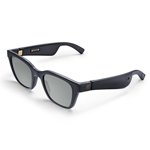
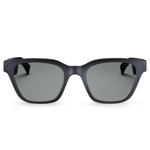
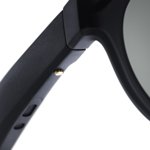
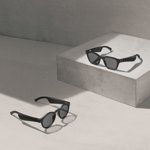

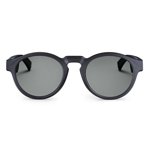
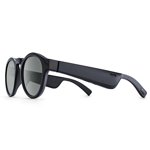








Product Overview
Bose Frames are sunglasses with interchangeable lenses that double as wireless headphones. They are also compatible with Bose AR augmented reality app, using the 9-axis head motion sensor.
Bose Frames come in two styles, square and angled. Both block up to 99% of UVA and UVB and feature uniformly tinted lenses. Gold-plated steel hinges and charging pins decorate the frame. Bose Frames are scratch and shatter resistant and lightweight.
They function like true wireless headphones. A minuscule, wafer-thin acoustic package is set in each arm's interior to produce discreet sound for the user, and no one else. A small microphone and multi-function button are embedded into the frame for touch and voice control.
Bose Frames are Bose AR compatible. Though it doesn't change what you see, it knows where you are and what you're facing using the 9-axis head motion sensor and the GPS from your smart device.
Ratings
What we found**
Pros
- Great sound quality
- Excellent battery life
- Bose AR app works well
Cons
- Nothing in particular
What external reviewers found***
External score 67% (not directly comparable across industries)
Pros
- Good sound quality
- Excellent audio performance
- Excellent call quality
- Good battery life
Cons
- Lacks bass depth
- Limited app support
- No wireless charging
- No IPX4 rating
- No EQ or useful extras
Price Comparison
Specifications
| Alto S/M | Alto M/L | Rondo | ||||||||||||||||||||||||||||||||||||||||||||||||||||||||||||||||||||||||||||||||||||||||||||||||||
|---|---|---|---|---|---|---|---|---|---|---|---|---|---|---|---|---|---|---|---|---|---|---|---|---|---|---|---|---|---|---|---|---|---|---|---|---|---|---|---|---|---|---|---|---|---|---|---|---|---|---|---|---|---|---|---|---|---|---|---|---|---|---|---|---|---|---|---|---|---|---|---|---|---|---|---|---|---|---|---|---|---|---|---|---|---|---|---|---|---|---|---|---|---|---|---|---|---|---|---|---|
Dimensions | ||||||||||||||||||||||||||||||||||||||||||||||||||||||||||||||||||||||||||||||||||||||||||||||||||||
| Frame | Bridge | 16 mm | 18 mm | 15.5 mm | |||||||||||||||||||||||||||||||||||||||||||||||||||||||||||||||||||||||||||||||||||||||||||||||||
| Frame | Lens | 51 mm | 52 mm | 49.5 mm | |||||||||||||||||||||||||||||||||||||||||||||||||||||||||||||||||||||||||||||||||||||||||||||||||
| Frame | Temple | 155 mm | 162 mm | 154 mm | |||||||||||||||||||||||||||||||||||||||||||||||||||||||||||||||||||||||||||||||||||||||||||||||||
| Weight | 1.58 oz | |||||||||||||||||||||||||||||||||||||||||||||||||||||||||||||||||||||||||||||||||||||||||||||||||||
Performance | ||||||||||||||||||||||||||||||||||||||||||||||||||||||||||||||||||||||||||||||||||||||||||||||||||||
| Battery Life | 3.5 h music playback / 12 h standby | |||||||||||||||||||||||||||||||||||||||||||||||||||||||||||||||||||||||||||||||||||||||||||||||||||
Production | ||||||||||||||||||||||||||||||||||||||||||||||||||||||||||||||||||||||||||||||||||||||||||||||||||||
| Availability | 2019-01 | |||||||||||||||||||||||||||||||||||||||||||||||||||||||||||||||||||||||||||||||||||||||||||||||||||
| Debut | 2018-12 | |||||||||||||||||||||||||||||||||||||||||||||||||||||||||||||||||||||||||||||||||||||||||||||||||||
Related Products
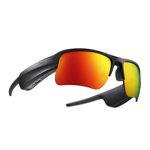
Bose Frames Tenor & Soprano Sunglasses and Tempo Sport Sunglasses w/ Integrated Wireless Headphones (2020)
67% External
Bose Tempo, Tenor, and Soprano are three new additions to the Bose Frames lineup of premium sunglasses with integrated wireless headphones. The Frames Tempo deliver the best performance and are perfect for outdoor workouts, while the Frames Tenor and S...
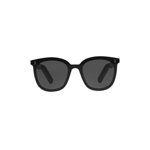
Huawei X Gentle Monster Eyewear II Sunglasses w/ Headphones
56% External
Huawei X Gentle Monster Eyewear II are the company's 2nd-gen smart glasses. Boasting a more avant-garde yet comfortable design, they offer a larger set of smart functions. The Eyewear II are designed with Huawei's acoustic privacy protection fe...

Razer Anzu Smart Glasses w/ Headphones
66% External
Razer Anzu Smart Glasses are stylish glasses with built-in headphones. Available with both 35% blue light filtering clear lenses and 99% UVA/UVB polarized sunglasses, the Razer Anzu is lightweight and versatile. The Anzu can pair with mobile devices wi...
Launch Comparison
Clear List
3rd-Party Review Videos





External Reviews
gizmodo[1]
Reviewer score 57%Open-ear audio sunglasses definitely aren't something that everyone needs. These are best suited for people who do lots of outdoor activity. For those with bad eyesight, you can get prescription versions of the Tempo or Soprano. No one should have to look chic while working up a sweat anyway.
Find the original article here.
Pros
- Good battery life
- Comfortable fit
- Good sound quality
Cons
- Not for everyone
cnet[2]
Reviewer score 71%Bose Frames are sunglasses that are "enhanced with Bose technology to play music and take calls" Available in two styles for $200, they're initially on sale only in the US. While they're a little bulkier than your typical sunglasses, they don't feel too heavy on your face.
Find the original article here.
Pros
- Sleek design
- Easy to use
Cons
- Sound isn't as good as the AirPods
digitaltrends[3]
Reviewer score 68%Bose's Frames offer plenty of enticing ways to splash some music or podcasts into your life, without ever losing touch with the world around you. They're IPX2 certified for basic water resistance, but that means they're only splash proof and can't withstand a serious douse. The Frames offer just 3.5 hours (or less) of playback time per charge.
Find the original article here.
Pros
- Gorgeous, colorful design
- Comfortable fit
- Excellent battery life
Cons
- Limited use cases
- Can’t charge in the case
nextpit[4]
Reviewer score 66%The Bose Frames Alto feature miniaturized speakers in the bulky part of each temple. They are positioned to project sound directly into your ear canal, but allow you to hear your surroundings. Sound quality when it comes to music streaming is the weakest of the use cases with the Frames. The Frames Alto are not a replacement for headphones then, absolutely not.
Find the original article here.
Pros
- Open-ear design
- Good sound quality
- Good battery life
Cons
- Sound quality could be better
pcmag[5]
Reviewer score 49%As sunglasses, the Bose Frames are comfortable and stylish. As headphones, they deliver impressive sonic performance for drivers that make no contact with your ears. There's an excellent crispness, which provides clarity, but this is not a terribly bass-infused audio experience. The Frames are made to work with Bose AR, and the company has provided developers with the SDK.
Find the original article here.
Pros
- Sleek, comfortable design
- Good audio quality
- Built-in glasses
Cons
- No prescription lenses
- No wireless charging
pcmag[6]
Reviewer score 64%The Bose Frames Tempo are a sport-focused pair of audio sunglasses. The focus is clearly on the mids and highs, and the vocals and acoustic strums receive excellent clarity. The trade-off here is the lack of bass depth that comes with the open design. Bose estimates battery life to be roughly 8 hours.
Find the original article here.
Pros
- Sleek, sport-friendly design
- Excellent audio performance
- Dual beam-forming mic array
Cons
- Lacks bass depth
- No EQ or useful extras
techadvisor[7]
Reviewer score 76%Bose Frames have a built-in microphone like many pairs of headphones. Music is delivered to the ears through ultra-precise geometry, at the same time being sampled and'silenced' by ports on the arms. With Bose Frames you can have a conversation with a mate whilst nodding along to Grimes, or just enjoy music without having that pressure of a bud in your ear.
Find the original article here.
Pros
- Sleek design
- Easy to use
- Smart Assistant
Cons
- No prescription lenses
techradar[8]
Reviewer score 64%The Bose Frames are an impressive piece of hardware. All of the augmented reality features on this pair of glasses are communicated via audio. The glasses themselves have trackers inside and use the GPS on your smartphone to work out your location. There are only six AR apps to choose from, and most of these focus on navigation and entertainment.
Find the original article here.
Pros
- Impressive AR features
- Excellent battery life
- Easy to use
Cons
- No charging case
- Limited app support
techradar[9]
Reviewer score 71%Bose Frames Tempo and Tenor and Soprano have improved sound quality. All three models have an improved mic system for clearer voice calls. Battery life has gotten a boost as well. Depending on which model you prefer, you can get up to 8 hours of playback from a single charge.
Find the original article here.
Pros
- Excellent call quality
- Water- and sweat-resistant
- Good battery life
Cons
- No IPX4 rating
- No wireless charging
tomsguide[10]
Reviewer score 82%Bose Frames pair over Bluetooth, so you can listen to everything from your podcast app to YouTube. You can also receive calls on the Bose Frames, by simply clicking the multifunction button. According to Bose, the Frames are rated for up to 3.5 hours of audio playback.
Find the original article here.
Pros
- Sleek, lightweight design
- Easy to use
- Easy-to-use app
Cons
- Can't be used with other Bose products
User Reviews
Comments
Please login before adding comments.
References
- ^ I Love The New Bose Frames Even If I Look Like an Absolute Jabroni. [gizmodo]. https://gizmodo.com/i-love-the-new-bose-frames-even-if-i-look-like-an-absol-1846132980. 2021-01-27. Retrieved 2021-03-22.
- ^ Bose Frames review: Audio sunglasses that sound surprisingly good. [cnet]. https://www.cnet.com/reviews/bose-frames-review/. 2019-02-01. Retrieved 2021-03-22.
- ^ Bose Frames Alto review. [digitaltrends]. https://www.digitaltrends.com/headphone-reviews/bose-frames-alto-review/. 2019-06-16. Retrieved 2021-03-22.
- ^ Bose Frames Alto review: don't throw away your headphones yet. [nextpit]. https://www.nextpit.com/bose-frames-alto-review. 2019-08-24. Retrieved 2021-03-22.
- ^ Bose Frames Review. [pcmag]. https://www.pcmag.com/reviews/bose-frames. 2019-02-07. Retrieved 2021-03-22.
- ^ Bose Frames Tempo Review. [pcmag]. https://www.pcmag.com/reviews/bose-frames-tempo. 2020-09-30. Retrieved 2021-03-22.
- ^ Bose Frames review. [techadvisor]. https://www.techadvisor.co.uk/review/bose-frames-review-3697242/. 2019-05-27. Retrieved 2021-03-22.
- ^ Bose Frames review. [techradar]. https://www.techradar.com/reviews/bose-frames-review. 2019-06-24. Retrieved 2021-03-22.
- ^ Bose Frames (Tempo, Tenor and Soprano) review. [techradar]. https://www.techradar.com/reviews/bose-frames-tempo-tenor-and-soprano. 2021-02-08. Retrieved 2021-03-22.
- ^ Bose Frames Review: Headphones Reinvented. [tomsguide]. https://www.tomsguide.com/us/bose-frames,review-6108.html. 2019-03-27. Retrieved 2021-03-22.
The MSRP provided on this page may not apply to all regions equally. For the current price, please refer to the Price Comparison section.
This page contains affiliate links to third-party merchants such as Amazon, eBay, and Rakuten. When you make a purchase using the supplied links, we will receive a commission.
These key takeaways ("pros" and "cons") and summaries are identified from third-party reviews. They may differ from the original texts.
<
>
x